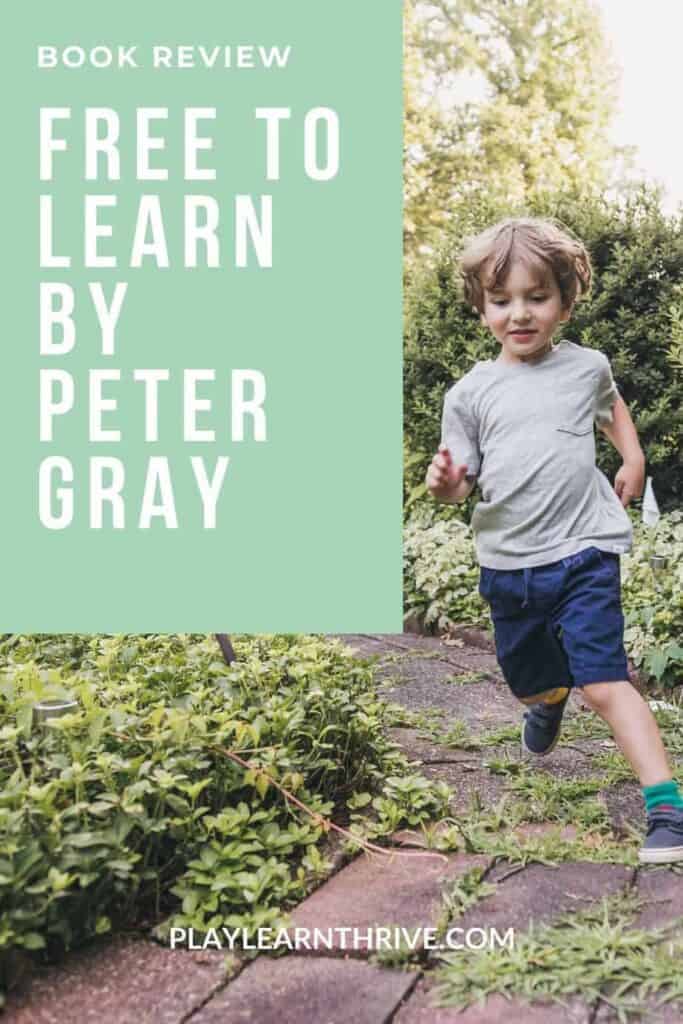Free to Learn by Peter Gray: A Book Review

Free to Learn by Peter Gray: A Book Review
As a public school educator and a parent, I am constantly reading topics about education, inquiry, and play. I love public schools, but there is no secret that time for play has been replaced with standardized test preparation in schools. At home, structured activities in the form of sports, dance, music, and more often take priority over free play. These activities are also important, but freedom to learn through unstructured play is something I am passionate about, both in school and at home.
Play. Learn. Thrive.™ only endorses products we authentically love and use. Some of the product links in this post may be affiliate links. That means that if you click them and make a purchase, this site makes a commission. Play. Learn. Thrive.™ is also an Amazon Associate. As an Amazon Associate, we earn from qualifying purchases. It will have no impact on the price you pay or the experience of your purchase.
In my doctoral studies, I came upon the book, Free to Learn: Why Unleashing the Instinct to Play Will Make Our Children Happier, More Self-Reliant, and Better Students for Life by Peter Gray, a research professor and scholar from Boston College. Although some of Gray’s ideas when it comes to education may seem extreme, there is a lot parents and teachers can learn from this book.
Gray writes that the decline in free play and emphasis on structured education and activities directly contributes to the rise in stress-related mental disorders and depression in young people. It comes down to this. When our children are able to make their own decisions regarding the when, where, why, and how of learning, they are more likely to learn and be motivated to learn.
Gray’s research draws on an anthropological study of hunter-gatherer children, a historical study of the impact of agricultural mores, feudalism, and monotheistic religion in the eventual rise of formalized, compulsory education. The historical context is an important review of the history of compulsory education, although not a comprehensive study. Gray’s focus goes beyond education itself and looks at learning.
Students Responsible for Their Own Learning
Sudbury Valley first operates on the principle that “adults do not control children’s education; children educate themselves”. In effect, learning is a uniquely personal experience. The student is part of the community. Students are not only responsible for decisions regarding their own learning but the decisions regarding the existence and responsibility of the school community as a whole.
The Seven Sins of Compulsory Education
In Free to Learn, Gray addresses the seven sins of our system of forced education. Whether you are homeschooling or your children are attending traditional school, these are important concepts to look at. Through extensive case studies of a private, radical constructivist school, Gray uses research to support the claim that formalized education guilty of the seven sins causes many students not to enjoy school. Gray addresses the need for students to be at the forefront of decisions when it comes to not only what they learn, but where, when, how, and even whom they learn from.
In the book, Gray focuses on the sins in our current system of compulsory education.
- Denial of liberty without just cause and due process
- Interference with the development of personal responsibility and self-direction
- Undermining of intrinsic motivation to learn (turning learning into work)
- Judging students in ways that foster shame, hubris, cynicism, and cheating
- Interference with the development and cooperation and promotion of bullying
- Inhibition of critical thinking
- Reduction in diversity of skills and knowledge
In addressing these “sins”, Gray studies Sudbury Valley School, a privately funded school founded in 1968 on the principles of self-directed, student-held responsibility of learning. Students and staff have a vested democratic say in the community through a “School Meeting” model.
The Denial of Liberty Without Just Cause and Due Process
Each of Gray’s “seven sins” have student ownership of learning as the focus. First is the denial of liberty without just cause and due process. The way to reinstate liberty is by allowing play. Gray said, “Play is always accompanied by the feeling of this is what I want to do right now”. Yes, play has rules, but the rules should be agreed upon by the group. This also allows for a democratic community.
Interference with the Development of Personal Responsibility and Self-Direction
Next, Gray focuses on the second “sin of our system of forced education”. This is interference with the development of personal responsibility and self-direction. Gray explains that the forced nature of schooling stifles curiosity that children are born with. Compulsory schooling turns learning into work, something to be avoided. When teachers take control of children’s learning and tell that work must come before play, then learning no longer becomes an act of joy but becomes work. Comparing student learning and work with other children not only becomes work but a source of anxiety which inhibits learning.
Undermining of intrinsic motivation to learn (turning learning into work)
The third sin of compulsory education, undermining of intrinsic motivation, starts when students enter formal schooling. No matter how engaging and fun teachers attempt to make class activities, learning tasks are traditionally referred to as “work”. Gray mentions that teachers often say, “you must do your work before you can play”. Using anthropological studies of hunter-gatherers and evidence of modern pre-school-aged children, Gray is able to assert that children are naturally playful and curious, and school, is ultimately what kills their desire to learn.
Judging students in ways that foster shame, hubris, cynicism, and cheating
The fourth sin is focused on the sins of grading by judging students in ways that foster shame. One of the most shameful parts of education, according to Gray, is the way we teach children that their worth is determined based on others' judgments through class rank or grades. Overall, when the value is placed on grading rather than learning, cheating becomes a preferable option for students faced with inferior grades or those competing in the cutthroat system of education.
Interference with the development of cooperation and promotion of bullying
Through segregation by age, caging students, and the atmosphere of competition, schools become places that interfere with the development of cooperation and promotion of bullying, the fifth sin. Children that develop at a slower rate physically, academically, or emotionally are placed with peers that may not relate with In addition, when students are allowed to age-mix, which is often seen in free play (think neighborhood children playing outside), the presence of younger children helps older youth develop their nurturing skills. The decline in age-mixed play has aligned with the rise of narcissism among youth. This lack of self-concern, according to Gray’s research, comes from the age-grading.
Inhibition of Critical Thinking
Curriculum, standards, and grading relate to the sixth sin of forced education, inhibition of critical thinking. Too often, grading rewards “correct” answers, and what is deemed correct in schools is the information and questions given to students from the teacher rather than students generating the questions.
The Sudbury Valley School, which serves as Gray’s model for schooling, does not assign grades. Students still report success beyond high school. Seventy-five percent pursued higher education and 82 percent of students reported that their education benefited them by helping them think more critically and take responsibility for their own learning. Gray, using qualitative research methods, studied graduates via surveys, which became additional research studies after Gray’s initial findings.
Reduction in diversity of skills and knowledge
Finally, the last sin is reduction in diversity of skills and knowledge through a system that focuses on all children rather than individuals. Standardized curriculum reduces opportunities for students to follow different pathways. In Sudbury Valley, students decide and propose what they will study and learn. Because the diversity of personalities and in knowledge is valued, students at the Sudbury Valley School are ultimately very successful in pursuits beyond secondary education.
What does this mean for parents and teachers?
What can parents and teachers learn from Gray's book? As a teacher, I still have faith in public education. I am not ready to uproot the entire system and disregard all standards and systems of aged socialization. However, there are a few things you can do as a classroom teacher or a parent to negate the seven sins.
Foster Inquiry
Kids are intrinsically curious, but too often schools tell them what questions to ask. By implementing Genius Hour or Passion Projects at school or home, your children will be able to explore and learn things that are authentic and meaningful to their own learning goals.
Give Choice
Instill elements of democratic learning by giving your children choice in the way they demonstrate their learning through the mode or output when it's applicable. I'm such a huge fan of Genius Hour in helping students reach their future goals. One of my students once told me that they didn't enjoy school because they weren't learning things that were going to help them in the future. That may only be partially true, but letting students explore their passions with specific learning targets and goals is so meaningful.
Allow Free Play
There's nothing that frustrates me more than when I see recess being taken away from young children. Even older children need time to experience “free play, but when our youngest learners are exchanging recess for testing, we're doing them no favors. Taking a little time away from structured school helps mental health for kids and teachers. Not only does free play help with social-emotional learning, it also increases imagination.
Embrace Boredom
It's more than OK for kids to be bored. Over-scheduling and even unintentional scholastic competition can lead to shame and cheating. Let your children learn for the sake of fun and curiosity and play without it being planned.
The 21st-century child is changing the world. Gray embraces play and student-direct learning, but even if your school or homeschool isn't curriculum-free or 100% student-led, looking at Gray's “seven sins” can certainly help you think about what today's education could be for your child when we bring back curiosity and play.
Jen Schneider is a middle school public school teacher and Ph.D. student in Omaha, Nebraska. She writes about education at Creative Tech Teacher.



![Playroom Ideas on a Budget [budget-friendly playroom ideas, furniture, storage & More]](https://playlearnthrive.com/wp-content/uploads/2023/03/playroom-ideas-on-a-budget-768x512.jpg)




